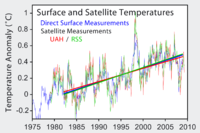
Photo from wikipedia
Along with climate change, unstable weather patterns are becoming more frequent. However, the temporal trend associated with the effect of temperature variation on schizophrenia (SCZ) is not clear. Daily time-series… Click to show full abstract
Along with climate change, unstable weather patterns are becoming more frequent. However, the temporal trend associated with the effect of temperature variation on schizophrenia (SCZ) is not clear. Daily time-series data on SCZ and meteorological factors for 15-year between January 1, 2005 and December 31, 2019 were collected. And we used the Poisson regression model combined with the time-varying distribution lag nonlinear model (DLNM) to explore the temporal trend of the association between three temperature variation indicators (diurnal temperature range, DTR; temperature variability, TV; temperature change between neighboring days, TCN) and SCZ hospitalizations, respectively. Meanwhile, we also explore the temporal trend of the interaction between temperature and temperature variation. Stratified analyses were performed in different gender, age, and season. Across the whole population, we found a decreasing trend in the risk of SCZ hospitalizations associated with high DTR (from 1.721 to 1.029), TCN (from 1.642 to 1.066), and TV (TV0–1, from 1.034 to 0.994; TV0–2, from 1.041 to 0.994, TV0–3, from 1.044 to 0.992, TV0–4, from 1.049 to 0.992, TV0–5, from 1.055 to 0.993, TV0–6, from 1.059 to 0.991, TV0–7, from 1.059 to 0.990), but an increasing trend in low DTR (from 0.589 to 0.752). Subgroup analysis results further revealed different susceptible groups. Besides, the interactive effect suggests that temperature variation may cause greater harm under low-temperature conditions. There was a synergy between TCN and temperature on the addition and multiplication scales, which were 1.068 (1.007, 1.133) and 0.067 (0.009, 0.122), respectively. Our findings highlight public health interventions to mitigate temperature variation effects needed to focus not only on high temperature variations but also moderately low temperature variations. Future hospitalizations for SCZ associated with temperature variation may be more severely affected by temperature variability from low temperature environments. The temporal trend is associated with the effect of temperature variation on schizophrenia (SCZ).
Journal Title: Environmental Science and Pollution Research
Year Published: 2021
Link to full text (if available)
Share on Social Media: Sign Up to like & get
recommendations!